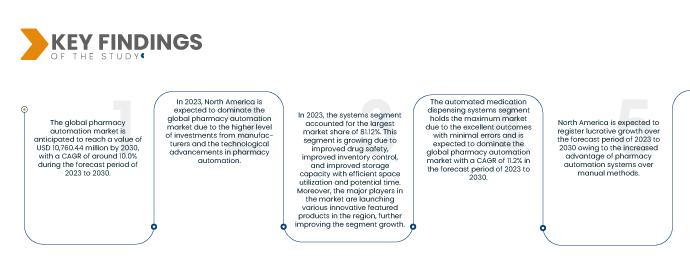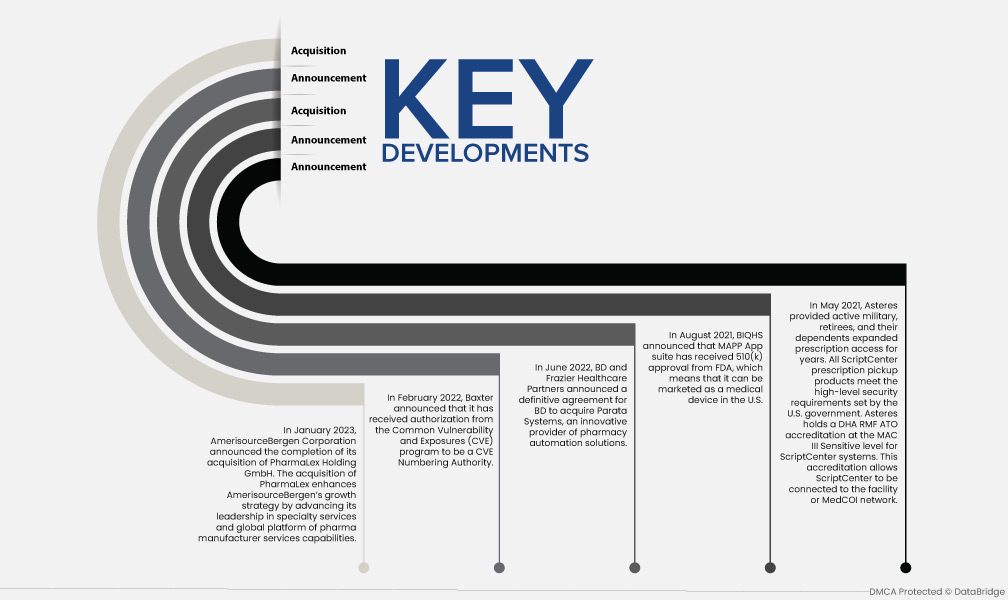The rising incidence of accidents and deaths due to medical drug errors puts tremendous pressure on the general healthcare sector. Both healthcare professionals and pharmacists are searching for more effective and accurate solutions to avoid such frequent medical malfunctions. In addition, with the increasing number of patients, visitors, and their respective safety needs, the drug delivery system becomes more complicated each passing day. In order to tackle this serious issue, advanced technologies such as pharmacy automation systems are now emerging as the most powerful tools. The goal of these instruments is to reduce medical prescription errors and maximize patient safety. Therefore, implementing such pharmacy automation systems helps healthcare service providers and pharmacists minimize their losses and improve quality and productivity.
Access full Report @ https://www.databridgemarketresearch.com/jp/reports/global-pharmacy-automation-market
Data Bridge Market Research analyzes that the Global Pharmacy Automation Market is expected to grow at a CAGR of 10.0% in the forecast period of 2023 to 2030 and is expected to reach USD 10,760.44 million by 2030. In 2023, the product segment is expected to dominate the market due to rising technological advancements and increasing demand for precise robotic tools in the regions.
Key Findings of the Study
ADVANTAGES OF PHARMACY AUTOMATION SYSTEMS OVER MANUAL METHODS
Drug delivery is the main responsibility of the pharmacy service and an integral part of the patient care process, and has a direct effect on clinical outcomes. The work of administering medication in a pharmacy consists of several steps and requires a large number of employees, raising the risk of medication errors and adverse incidents. In several countries, including the U.S. and Canada, and in some private hospitals in Thailand, automated dispensing machines (ADMs) are commonly used. The anticipated benefits of deploying ADMs in the dispensing process include more effective use of human resources and enhancing the efficiency of the drug delivery process. From the introduction of automated technology in its workflows, the pharmacy has plenty to benefit from. While the initial investment in these systems could cause pharmacies to pause, any downsides far outweigh the immediate and long-term benefits. Moreover, with government legislation and patient needs continuing to push pharmacies, the adoption of pharmacy automation is becoming a necessity that aids in the market growth.
Pharmacy automation systems have strengthened the pharmacy operations process, such as medication filling & capping, drug administration & storage, and prescription labeling. These systems can store and handle, in an efficient and safe manner, more than 200-300 medicines and patient information.
It is expected that increased implementation of automated systems would ensure notable efficiency and increase the number of medications served by the pharmacy by reducing long-term running costs. Thus, the advantages of pharmacy automated systems over manual systems act as a driver for market growth.
Report Scope and Market Segmentation
|
Report Metric
|
Details
|
|
Forecast Period
|
2023 to 2030
|
|
Base Year
|
2022
|
|
Historic Year
|
2021 (Customizable to 2015 - 2020)
|
|
Quantitative Units
|
Revenue in Million and Pricing in USD
|
|
Segments Covered
|
Product (Systems, Software, and Services), Pharmacy Type (Independent, Chain, and Federal), Pharmacy Size (Large Size Pharmacy, Medium Size Pharmacy, and Small Size Pharmacy), Application (Drug Dispensing and Packaging, Drug Storage, and Inventory Management), End User (Inpatient Pharmacies, Outpatient Pharmacies, Retail Pharmacies, Online Pharmacies, Central Fill/Mail Order Pharmacies, Pharmacy Benefit Management Organizations, and Others), Distribution Channel (Direct Tender and Third Party Distributor)
|
|
Countries Covered
|
U.S., Canada, Mexico, Germany, France, Italy, U.K., Spain, Netherlands, Russia, Switzerland, Turkey, Belgium, rest of Europe, Japan, China, India, South Korea, Australia, Singapore, Malaysia, Thailand, Indonesia, Philippines, rest of Asia-Pacific, Brazil, Argentina, rest of South America, Saudi Arabia, South Africa, U.A.E., Israel, Egypt, and rest of Middle East and Africa
|
|
Market Players Covered
|
ARxIUM (U.S.), OMNICELL INC. (U.S.), Cerner Corporation (U.S.), Capsa Healthcare (U.S.), ScriptPro LLC (U.S.), RxSafe, LLC. (U.S.), MedAvail Technologies, Inc. (Canada), Asteres Inc. (U.S.), InterLink AI, Inc. (U.S.), BD (U.S.), Baxter (U.S.), Fullscript (Canada), McKesson Corporation (U.S.), Innovation Associates (U.S.), AmerisourceBergen Corporation (U.S.), UNIVERSAL LOGISTICS HOLDINGS, INC (U.S.), Takazono Corporation (Japan), TOSHO Inc. (Japan), Willach Group (Germany), BIQHS (Portugal), Synergy Medical (Canada), Yuyama (Japan), APD Algoritmos Procesos y Diseños S.A (Spain), JVM Europe BV (Netherlands), Genesis Automation LTD (Italy), myPak Solutions Pty Ltd. (Australia), Demodeks Pharmacy Shelving (Australia), Deenova S.r.l. (Italy), KUKA AG (Germany), and KLS Pharma Robotics GmbH (Germany) among others
|
|
Data Points Covered in the Report
|
In addition to the insights on market scenarios such as market value, growth rate, segmentation, geographical coverage, and major players, the market reports curated by the Data Bridge Market Research also include depth expert analysis, patient epidemiology, pipeline analysis, pricing analysis, and regulatory framework.
|
Segment Analysis
The global pharmacy automation market is segmented into product, pharmacy type, pharmacy size, application, end user, and distribution channel.
- On the basis of product, the market is segmented into systems, software, and services. In 2023, the systems segment is expected to dominate the market with a market share of 81.12%.
On the basis of pharmacy type, the market is segmented into independent, chain, and federal
- On the basis of pharmacy type, the market is segmented into independent, chain, and federal. In 2023, the independent segment is expected to dominate the market with a market share of 47.23%.
- On the basis of pharmacy size, the market is segmented into large size pharmacy, medium size pharmacy, and small size pharmacy. In 2023, the large size pharmacy segment is expected to dominate the market with a market share of 53.21%.
- On the basis of application, the market is segmented into drug dispensing and packaging, drug storage, and inventory management. In 2023, the drug dispensing and packaging segment is expected to dominate the market with a market share of 54.21%.
- On the basis of end user, the market is segmented into inpatient pharmacies, outpatient pharmacies, retail pharmacies, online pharmacies, central fill/mail order pharmacies, pharmacy benefit management organizations, and others. In 2023, the inpatient pharmacies segment is expected to dominate the market with a market share of 65.11%.
On the basis of distribution channel, the market is segmented into direct tender and third party distributor
- On the basis of distribution channel, the market is segmented into direct tender and third party distributor. In 2023, the direct tender segment is expected to dominate the market with a market share of 78.87%.
Major Players
Data Bridge Market Research recognizes the following companies as the market players in the global pharmacy automation market that include ARxIUM (U.S.), OMNICELL INC. (U.S.), Cerner Corporation (U.S.), Capsa Healthcare (U.S.), ScriptPro LLC (U.S.), RxSafe, LLC. (U.S.), MedAvail Technologies, Inc. (Canada), Asteres Inc. (U.S.), InterLink AI, Inc. (U.S.), BD (U.S.), Baxter (U.S.), Fullscript (Canada), McKesson Corporation (U.S.), Innovation Associates (U.S.), AmerisourceBergen Corporation (U.S.), UNIVERSAL LOGISTICS HOLDINGS, INC (U.S.), Takazono Corporation (Japan), TOSHO Inc. (Japan), Willach Group (Germany), BIQHS (Portugal), Synergy Medical (Canada), Yuyama (Japan), APD Algoritmos Procesos y Diseños S.A (Spain), JVM Europe BV (Netherlands), Genesis Automation LTD (Italy), myPak Solutions Pty Ltd. (Australia), Demodeks Pharmacy Shelving (Australia), Deenova S.r.l. (Italy), KUKA AG (Germany), and KLS Pharma Robotics GmbH (Germany) among others.
Market Developments
- In January 2023, AmerisourceBergen Corporation announced the completion of its acquisition of PharmaLex Holding GmbH. The acquisition of PharmaLex enhances AmerisourceBergen’s growth strategy by advancing its leadership in specialty services and global platform of pharma manufacturer services capabilities.
- In February 2022, Baxter announced that it has received authorization from the Common Vulnerability and Exposures (CVE) program to be a CVE Numbering Authority.
- In June 2022, BD and Frazier Healthcare Partners announced a definitive agreement for BD to acquire Parata Systems, an innovative provider of pharmacy automation solutions.
- In August 2021, BIQHS announced that MAPP App suite has received 510(k) approval from FDA, which means that it can be marketed as a medical device in the U.S.
- In May 2021, Asteres provided active military, retirees, and their dependents with expanded prescription access for years. All ScriptCenter prescription pickup products meet the high-level security requirements set by the U.S. government. Asteres holds a DHA RMF ATO accreditation at the MAC III Sensitive level for ScriptCenter systems. This accreditation allows ScriptCenter to be connected to the facility or MedCOI network.
Regional Analysis
Geographically, the countries covered in the pharmacy automation market report are the U.S., Canada, Mexico, Germany, France, Italy, U.K., Spain, Netherlands, Russia, Switzerland, Turkey, Belgium, rest of Europe, Japan, China, India, South Korea, Australia, Singapore, Malaysia, Thailand, Indonesia, Philippines, rest of Asia-Pacific, Brazil, Argentina, rest of South America, Saudi Arabia, South Africa, U.A.E., Israel, Egypt, and rest of Middle East and Africa.
As per Data Bridge Market Research analysis,
North America is the dominant region in the global pharmacy automation market during the forecast period of 2023 to 2030
In 2023, North America is expected to dominate the global pharmacy automation market owing to the higher level of investments by various manufacturers and increasing technological advancements in the region. North America will continue to dominate the global pharmacy automation market in terms of market share and market revenue and will continue to flourish its dominance during the forecast period.
Asia-Pacific is the fastest growing region in the global pharmacy automation market during the forecast period of 2023 to 2030
Asia-Pacific is estimated to be the fastest-growing region in the global pharmacy automation market in the forecast period of 2023 to 2030. This is due to the growing adoption of advanced technology and the launch of new products in this region.
For more detailed information about the global pharmacy automation market report, click here – https://www.databridgemarketresearch.com/jp/reports/global-pharmacy-automation-market














